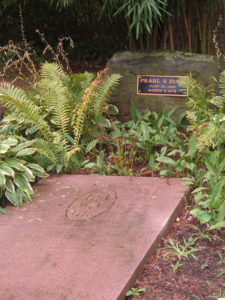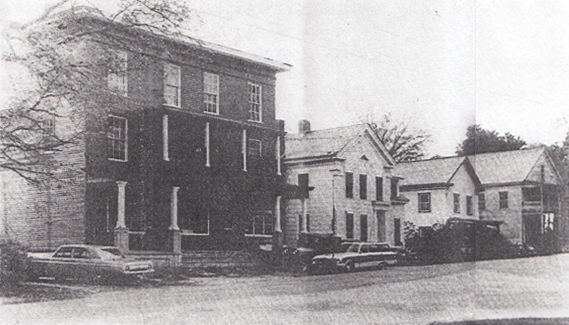Pearl Buck, famous American writer and novelist, spent much of her life calling the beautiful mountains of Vermont home. In her later years, though her house was only 30 miles from the small village, Pearl discovered Danby for the first time and fell in love. It was through her business manager who purchased the then crumbling country store that Pearl Buck came to be so involved in the revival of Danby.
Seeing that the town had beautiful and prosperous beginnings, Pearl became consumed with the history of both the people and the industry of the area. She spent much time and money helping her business manager to restore the old country store and learn as much as possible about the increasingly rejuvenated area.
In the last years of her life Pearl Buck wrote fondly of Danby and the new beginning she was witness to in the early 1970’s. She contributed greatly to both the spirit and rebuilding of Danby Village, and she will always be honored by its residents.
The Vermont Village Square

Pearl Buck bought these 4 buildings in 1968 and 1969 and called it The Vermont Village Square, using a red and white color scheme on the exterior. She formed a corporation, Creativity, Inc. which held title to the buildings.
PBS interview with Pearl Buck talking about the restoration.
Pearl’s Gravesite
The flush grave marker at the gravesite of Ms. Buck is made of Vermont granite. Ms. Buck spent many happy family vacations in Vermont and died of cancer while in Vermont on March 6, 1973 at the age of 80.
The oval shaped engraving in the ancient Chinese calligraphy style is reflective of the birth name of Ms. Buck. This symbol is her personal signature, known as a chop. It is similar to what we may associate with an Egyptian hieroglyphic symbol associated with a name, as a cartouche.
At the head of the grave is a granite stone also from Vermont, with a traditional brass grave inscription in English.
The Chinese characters are three words, precious then the next is gem for the name Pearl.
The last one is silk knitter which is a cognate for her German maiden name of Sydenstricker.
This chop signature translates as Precious gem silk knitter for Pearl Sydenstricker.
Gravesite of Pearl’s Daughter
“For years, Pearl Buck’s daughter was buried in an unmarked grave in New Jersey. One fan made it his mission to change that.”
Read in the Philadelphia Inquirer.
Photos
Click to view larger.

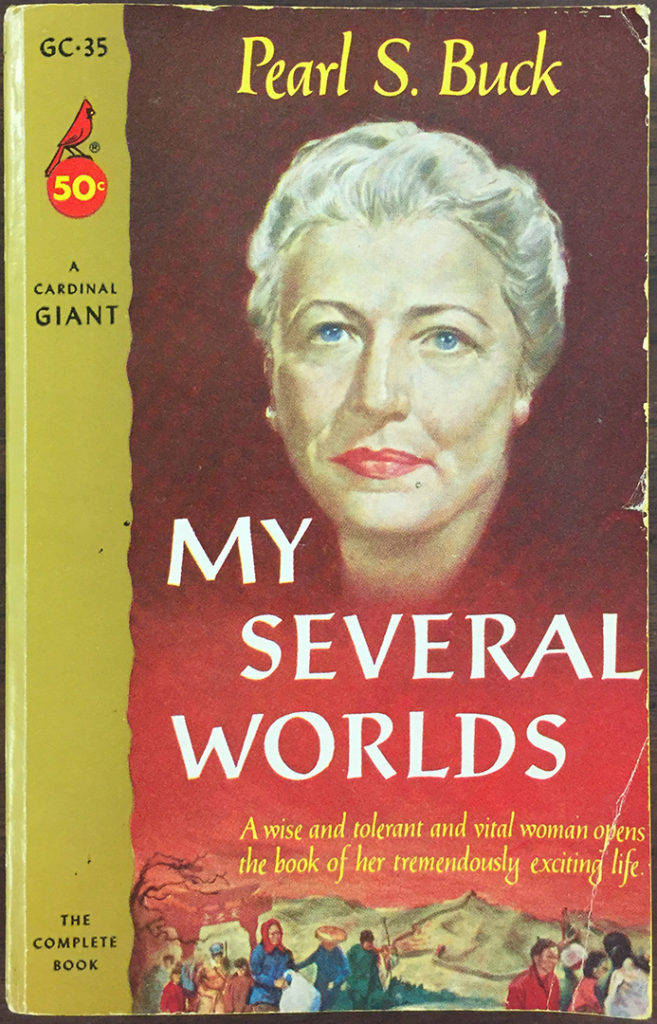
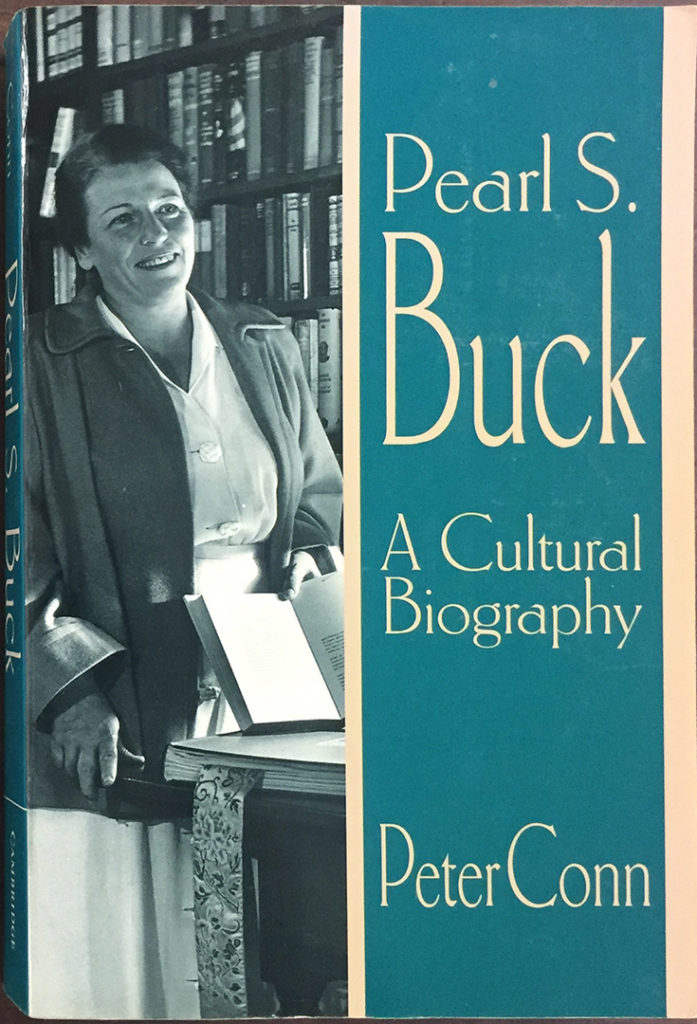


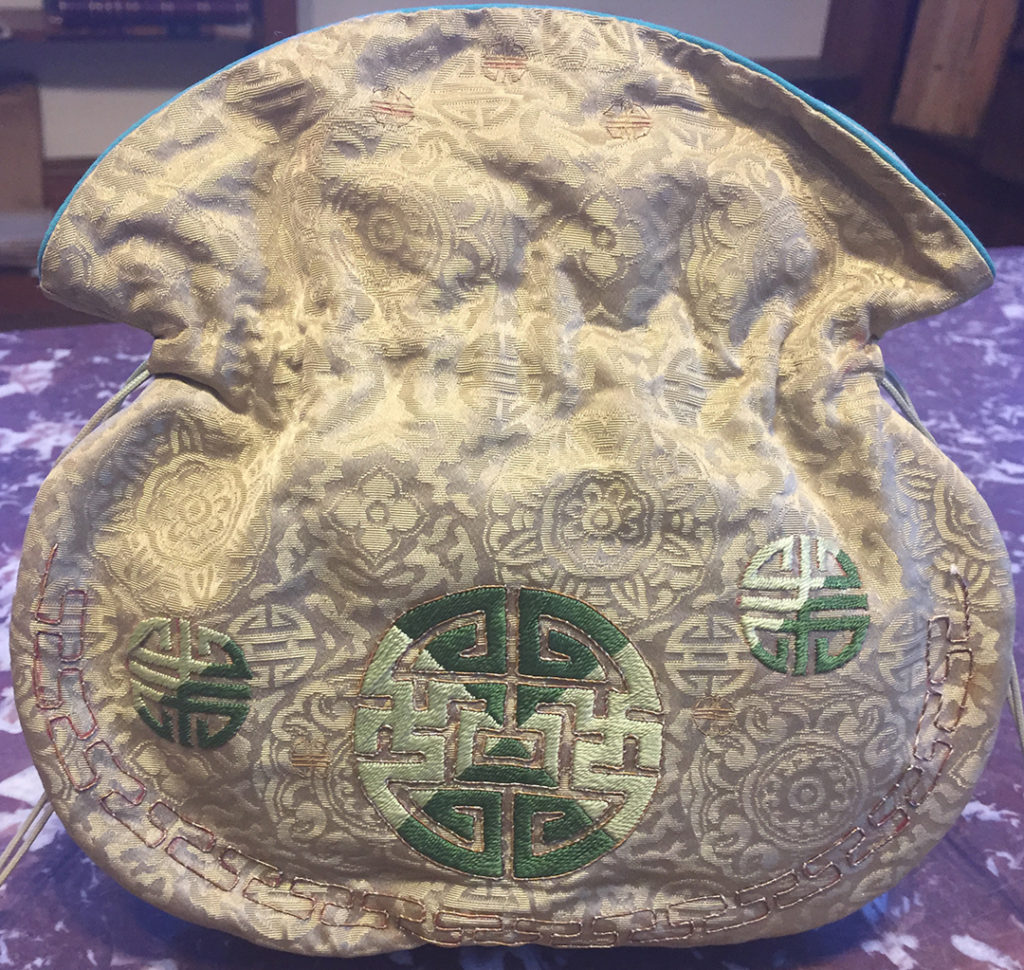
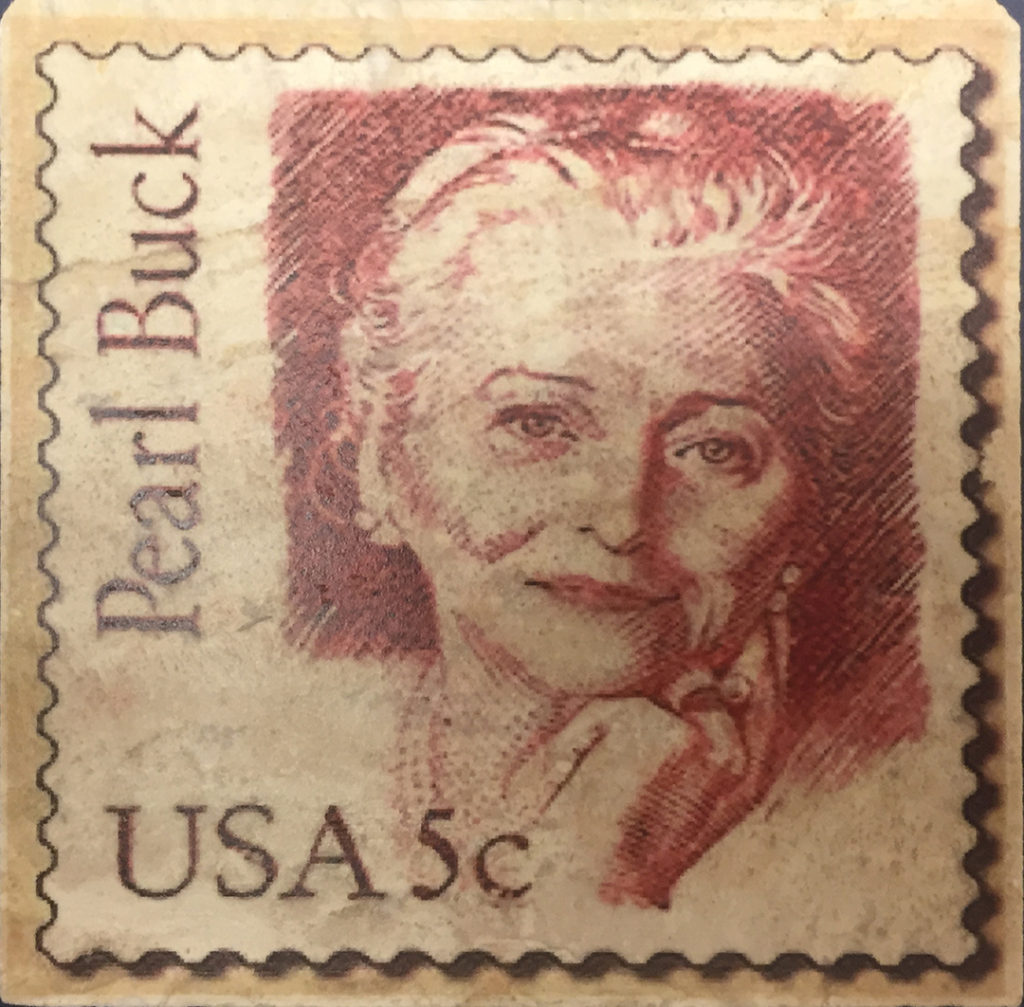
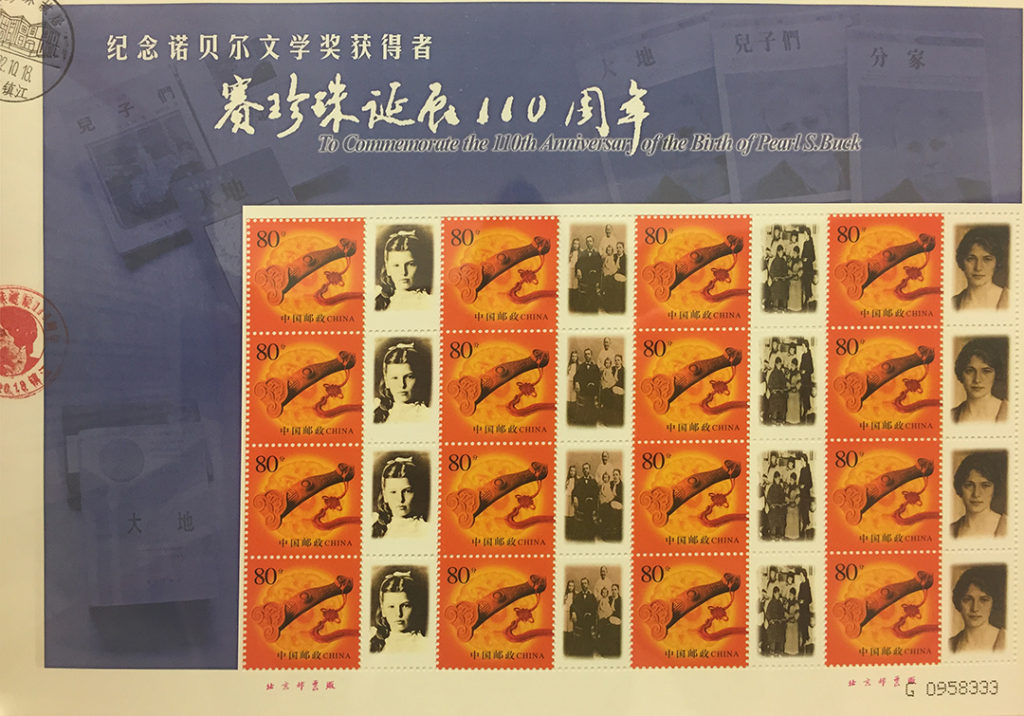
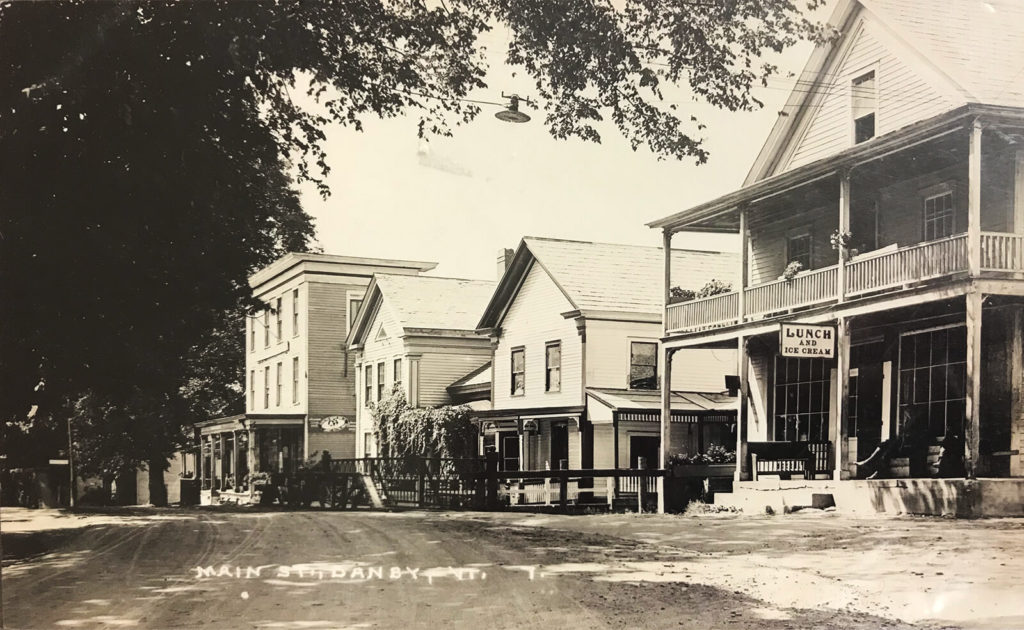

Newspaper Clippings
Click to view larger.
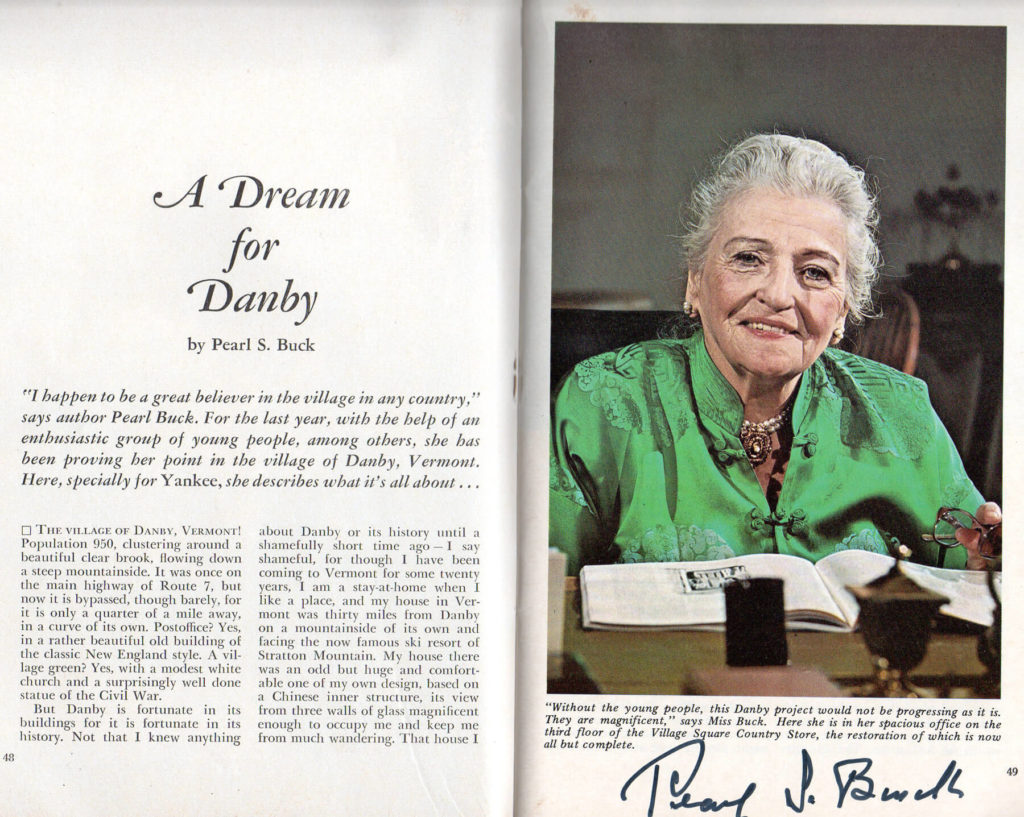

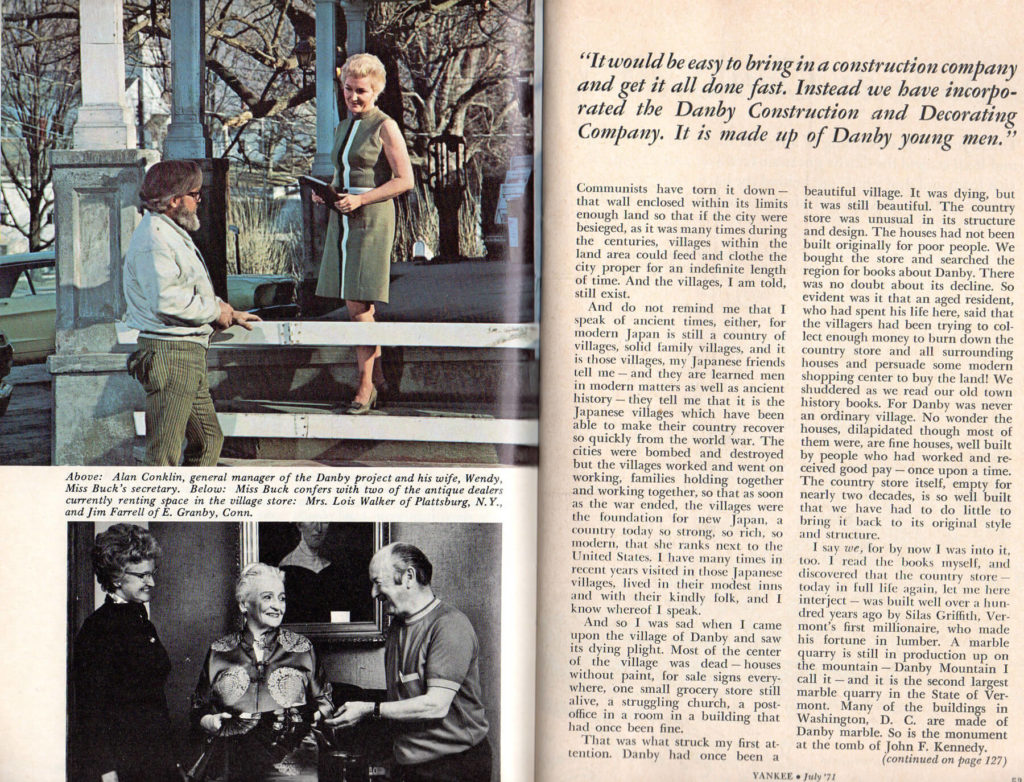

4th of July Weekend
The Vermont Village Square has all come together in time for the 4th of July weekend. From the original building (which opened in 1969 and housed antiques, The Country Store and The Maple Skillet) has grown 3 additional buildings. Thus, we now see four restored buildings housing the original nucleus as well as providing room for a total of 40 antique dealers. This does not include the Flea Market which will run each weekend throughout the summer. and fall. The Maple Skillet is now under the management and operation of Aunt Bea, who takes second place to no person in the quality and quantity of her food and fountain delights. And Grandma Perry’s pies have become a legend unto themselves. Now that The Country Store is under the supervision of Dottie Ralph, the merchandise has taken on a much more diversified appearance. Dottie’s turkey duster never stops which makes neatness and appearance an invitation to browse. We don’t know if her Vermont heritage is responsible – but the quality of the Vermont Cheddar now backs away from no other wheel in our State.
Danby to be on Beaten Path Again Soon
Author Pearl Buck Behind Tourists’ Cultural Center Development
By Aldo Merusi
Danby, isolated when U.S. Route 7 was rerouted, will soon be on the beaten path again.
Several dilapidated buildings huddled together just north of Griffith Library on the west side of the narrow twisting Main Street are being rapidly restored by the Vermont Village Square Inc., whole principal stockholders are Miss Pearl Buck, noted author, and her biographer, Theodore Harris.
Harris, who has just completed his second volume on the life of Miss Buck, said Wednesday, a country store will be opened in the long vacant Rosen General Store, and an arts and crafts center, antiques shop and restaurant in the adjacent homes sold to the corporation by Mr. and Mrs. Alvin Reed and Mrs. Mabel Stevens who are in the process of moving out.
The original tannery building, owned by Mr. and Mrs. Phillip Barnes of Greenville, Pa., which was once the town office, will also be utilized by the corporation in its ambitious project.
Opening of the country store is scheduled for before the Christmas season maybe as early as Thanksgiving Day.
The Vermont Village Square firm is a subsidiary of Creativity Inc. which operated until it sold recently Old Mills Enterprises in Stratton where Miss Buck has a summer home.
The Rosen store, built in 1865 by Silas Griffith, Danby’s lumber magnate, was at one time considered the tallest business block in Southern Vermont.
It was purchased about 1920 by Abram Rosen from W.B. Griffith, and sold to one of Rosen’s daughters, Mrs. Michael Strauss of Danby and Ocenside, NY. Strauss is a sports writer for the New York Times.
A professional staff will operate the at the center, bewhiskered Harris stated, including Mrs. Mary Pauls of Los Angeles, well known west coast artist. Manager will be Thomas Leypoldt of Stratton.
Mr. and Mrs. Alan Conklin of Livingston Texas will run a department of ceramics.
The corporation is in the process of extending its real estate holding in the area. The old weather beaten tannery building stands on the south side of the bridge where the road leads to Danby Four Corners.
Danby is now a community of sidewalk superintendents as citizens in small groups watch the process of change.
“We’re going to be on the map again,” voiced a farmer behind the smoke screen of his venerable pipe.
Pearl S. Buck, The Jewel of Danby
By REBECCA CLARK
In 1938, much to her surprise, Pearl S. Buck was awarded the Nobel Prize for Literature in honor of her novel, “The Good Earth,” a story portraying the epic struggles of a Chinese peasant family.
When first informed of the award, she was so surprised she thought there must have been some mistake.
Three decades later, in 1970, she moved to Danby, Vt., and it was here in this small community three years later that “Miss Buck,” as she was known, passed away.
Her move to Danby, she explained in a 1971 magazine article, had been an attempt to rediscover the comfort and simplicity of the Chinese villages in which she had grown up — and about which she had written about so evocatively in “The Good Earth.”
“I happen to be a great believer in the village in any country. Great cities a nation must have and great industries, too, but they need the villages to draw upon,” she wrote.
“Miss Buck” had great plans for the small village of Danby. In 1968, working through business associates, she purchased six buildings and created the Vermont Village Corp., essentially buying up the center of Danby. Her purchases included both the country store and a book store above her antique shop, which offered mostly the books she had written.
Her attempts to forge a “better life” for the town of Danby were often met with scorn. Her dreams for Danby were never realized, but like a good novel, her sojourn created controversy, mystery and many unanswered questions.
Without One Good Friend
Although Pearl Buck lived in the heart of Danby for three years, she seems to have died there without one good friend, residents recalled. The internationally known novelist and her normally garrulous and sociable neighbors did not always see eye to eye. As one current Danby resident remembered, “The group of people she brought with her didn’t sit well with the town.”
When “Miss Buck” and her entourage moved into the roadside house across from the town clerk’s office, she had great aspiration, for the small village that was best known for its marble quarries. She came with a houseboy, a business manager who doubled as a ballroom dance instructor, a general manager, a secretary, and several others who were called “hangers on” by Danby observers.
“It was a new, exciting experience for everyone in Danby to hove a famous person living here.” said Cecille Colvin, a longtime resident of Danby who kept house for Pearl Buck. According to Colvin, “Miss Buck” did not have much interaction with the residents. “It was a shame that no one really got to know her. She was truly a dear person,” Colvin said.
In Danby, where 20-year residents are still considered newcomers, Pearl Buck was a novelty at best. Throughout her short time spent living in the town, Buck remained a mystery to the people of Danby, and they to her. She had great plans for the town and the people in it, but the dream was never completed, and the gap was never bridged.
“When she came to Danby, she was kind of exhausted and worn,” said Joan Bromley, librarian in Danby and a resident since 1946. Apparently, Buck had the same opinion of the town. “Danby? What I saw was a lovely old village, but it was dying. I could see that at a glance,” she wrote in an article for Yankee Magazine in July of 1971.
Buck was 78 years old when she moved from her self-described “odd but huge and comfortable” house in Bondville to Danby. She had only been in Danby once before she moved into the house purchased on her behalf by her business associates. She wrote: “Not that I knew anything about Danby or its history until a shamefully short time ago — I have been coming to Vermont for some 20 years, I am a stay-at-home when I like a place, and my house in Vermont was 30 miles from Danby on a mountainside of its own.”
Why did she move? Because “one’s life with a house ends, I have discovered, when the purpose for which it was built is fulfilled.”
An Adopted Family
Pearl S. Buck was born Pearl Comfort Sydenstricker in Hillsboro, Va., in 1892. Her father, Andrew, was a Presbyterian missionary who chose the inhabitants of southern China as the objects of his good doings. He brought his family to live with him there, including the infant Pearl, who consequently learned to speak Chinese before she learned English.
Pearl adopted the Chinese people as her own people and grew to love the culture. That love became the object of most of her writings, including “The Good Earth.” Along with the Nobel Prize, “The Good Earth” also won the Pulitzer Prize in 1931.
She grew up in a Chinese village, not an American compound where most missionaries lived with their families. Pearl thought of herself as no different from the Chinese, and she saw herself as being treated as an equal among them. She received a nasty awakening to the separation of racial discrimination as a result of the Boxer Rebellion of 1901. She and her family were forced to hide in order to avoid the certain death which awaited foreigners in China at that time. The Empress Dowager had decreed that all whites were to be killed. Luckily, the Sydenstrickers had loyal friends in the village who hid them away until the rebellion was over.
Following her marriage in 1917 to John Lossing Buck, an agricultural missionary in China, Pearl decided she wanted children. In a book published later, “This Proud Heart,” the heroine says, “I want to be the best wife in the world, the best mother.” Her first child, Carol, was born brain-damaged and sent to a home in America. After an operation which prohibited any more childbearing, Buck decided to adopt children, which became a life-long mission for her.
By the end of her life, “Miss Buck”had adopted nine children, seven of them female, of Asian or American-Asian decent. She also began an adoption service entitled “Welcome House” for these “unwanted” children who were viewed as neither American nor Chinese.
An Extension
After the move from Bondville to Danby, Miss Buck began building an extension on to the house she had purchased. The extension was 6,000 square feet. The three stories were to include an office for her writing overlooking the brook behind the house, a room for her parrot, and a large room on the first level for entertaining. The planned extension still stands, empty from top to bottom, an unwitting monument marking Buck’s death — and the end of the construction.
Part of Pearl Buck’s plan for the village was to make the villagers a part of the reformation, making them feel as if it were their project as well, not something imposed upon them, but something which included a part of them. She incorporated the Danby Construction and Decorating Co. Members of the restoration crew were Danby residents, mostly teenagers. “We will do nothing for you,” was Buck’s philosophy, “but we will give you the chance to do something for yourselves.”
The house was an anomaly for the Danby residents. The extension, almost larger than the house itself, I black and covered with metallic silver insulation paper. It has stood abandoned since Pearl Buck’s death in March of 1973, the hulking shell now a testament to her deferred dreams.
“Their biggest dream was the antique shop, ’The House of Miscellaneous,’” said Phyllis Leypoldt, a resident of Danby for 21 years. Mrs. Leypoldt came to Vermont from Pennsylvania along with her late husband at the request of Miss Buck. She and her husband, the administrative assistant to Buck in Pennsylvania, were asked to come and operate the country store in Bondville. They moved to Danby in 1967 in order to run what is now Nichol’s Country Store. Two years later, Buck joined them from Bondville. Soon after that, Mrs. Leypoldt quit her job with “Miss Buck” and told her husband she wanted to leave, saying she was unhappy.
The uneasy relationship between Mrs. Leypoldt and Buck and her business associates went back and forth for a period of years. The Leypoldts did not leave, but Mrs. Leypoldt began work again, then quit, then went back, solely for financial reasons. The Leypoldts were not making the money they had been told they would be making when they left Pennsylvania.
“My husband had been told he would get 50 percent of the high markups, but there were no high markups.”
The cause of her unhappiness was not “Miss Buck” — “She was a beautiful woman,” said Leypoldt. Her problem was with a man named Theodore Harris, Pearl Buck’s business manager and former ballroom dance instructor, according to Leypoldt. Harris appeared in Vermont with Buck and seems to have been at least partially responsible for alienation of “Miss Buck” from the people of Danby, Leypoldt said.
Harris could not be reached for comment. His whereabouts are unknown.
“Miss Buck” took walks in the village every day, always accompanied by Ted Harris, Leypoldt said.
“I felt he always had a hand on her shoulder,” said Mrs. Bromley. She repeated the opinion held at that time by some residents of the village that “Miss Buck” was kept separated from them by the overbearing and often impolite Harris.
“He was very protective of her,” said Cecille Colvin, “that man had great admiration and affection for that lady. He wasn’t what people thought he was, I worked with him and I liked him.” Mrs. Colvin felt that perhaps the townspeople didn’t reach out as much as they could have. “I was very fortunate to have known her. and I am sorry more people didn’t have the same privilege.”
Everyone in town knew her at least from a distance. “She would autograph books in the second floor of the antique shop,” said Joan Bromley. “She was a big, statuesque woman with very nice carriage. She was very lovely, always wore beautiful Chinese satin. She was dignified and always polite.”
According to Colvin, “Miss Buck” spent “two to three hours each day in the cafe on the corner,” autographing books and talking with residents. Colvin spent quite a bit of time in the Buck household and confided that “Miss Buck’s” daily routine was not anything out of the ordinary. “She was much more active in the beginning of her time in Danby; in the later years she wis basically confined to the house.”
Mrs. Leypoldt said she knew “Miss Buck,” but did not know her intimately. She is the only member of the group of people who came with “Miss Buck” to Danby, who still resides in Danby. The attitude at the Buck house was one of formality, “even I didn’t go to the house without being invited,” she said.
She says her husband knew “Miss Buck” better than she did. “He used to drive her around, and he would tease her about how she should drive and he would sit in the back. She thought that was funny. My husband also taught ‘Miss Buck’s’ parrot to say `Hi, old lady.’ She would always laugh at that.”
Mrs. Leypold’s brother was once in a Salvation Army home. She tried unsuccessfully for a period of time to get him out. “When ‘Miss Buck’ found out about it, she was very sympathetic, probably because she had a daughter in a home. She was instrumental in getting him out, cut right through all the red tape.”


